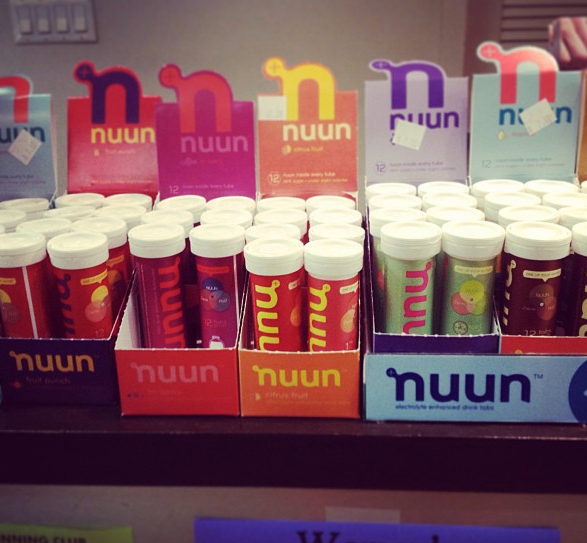Summer Hydration Tips from Nuun

With summer just around the corner it’s a great time to review hydration basics before you set out to train for your next event or spend time in the sun.
We recently partnered up with nutritionist-and-athletes Jesse & Jaime at The Core Diet to put together these tips and tricks for Brooks Running, but even the most well-hydrated folks out there (Nuun drinkers!) can use a refresher this time of year.
- -Have you ever calculated your sweat rate?
- -Do you know how much water you should be drinking per day?
- -Do you know about the risks of hyponatremia?
Read our hydration basics to learn more!
By Jesse Kropelnicki & Jaime Windrow – The Core Diet
As the hot weather months approach, you should move hydration to the top of your athletic priority list. Although hydration is an important factor year-round to overall health, slight dehydration of even 2% of your body weight can negatively affect performance, and your chances of this happening in the upcoming months are much higher. It’s been shown in studies that this nutritional intervention of staying properly hydrating is the best way to enhance or improve performance.
The most common situations that cause athletes run into dehydration troubles:
- -More than 1 training session per day.
- -Competitions held in hot and/or humid environments; if the athlete is coming from a colder climate, the impact is even larger.
- -Competitions of long duration such as marathons and triathlons (specifically half and full ironman distances).
Signs that you’re dehydrated:
- -Dizziness, confusion, lightheaded
- -Dry lips, mouth and skin
- -Physical and metal fatigue
- -Decrease pace and performance
- -Darkened urine (one of first indicators because the kidneys are very sensitive and they will let you know!)
- -Increased body temperature, HR and RPE
But don’t “over-hydrate”! (Hyponatremia)
While drinking water is important, another major factor that can impair performance is hyponatremia. This metabolic condition in which there is not enough sodium (salt) in the body fluids can be caused by over-hydrating and/or hydrating with only water, which can flush electrolytes from your body. Electrolyte drinks such as Nuun are perfect for pre-event or during the day hydration as they contain sodium but without much of the un-needed carbohydrates many sports drinks have.
Some signs of hyponatremia:
- -Nausea and vomiting
- -Headache
- -Confusion
- -Loss of energy
- -Fatigue
- -Restlessness and irritability
- -Muscle weakness, spasms or cramps
- -Seizures
- -Unconsciousness
- -Coma
How much water should I drink?
Drink fluids throughout the day and before/during/post workouts. Maintaining a good hydration status on a daily basis by staying a step ahead of dehydration is the best approach. Waiting until you are thirsty to drink fluids is too late – you are already dehydrated and you’ll find yourself constantly playing the game of catch-up!
Each day try to consume half your body weight (in pounds) in liquid ounces PLUS what you sweat out in training (your sweat rate). For example, if you weigh 150 pounds, you should aim to consume 75 ounces of water or electrolyte drink per day plus losses that occur during workouts.
Calculating Your Sweat Rate
Average sweat rate is typically 1 – 1.5L of fluid per hour (32-48oz), and 500 – 1,500mg of sodium per hour, however your personal sweat rate will depend on several factors such the environmental conditions (temperature, humidity); genetics, and the athletic conditioning of the athlete.
Your sweat rate can be determined by a simple “sweat test”:
- Take body weight before a one-hour moderate intensity bike or run.
- Record the amount of liquid consumed during workout, and weigh yourself again after the workout.
- Calculate the weight change and remember to add in the amount of liquid consumed during the workout.
- Every pound lost during your workout is equal to 16 oz of fluid.
Most people’s sweat contains about 500mg of sodium per 16oz. Very salty sweaters can have up to 1000mg or 1500mg per 16oz of sweat. As a very general rule of thumb, during long walking or running events, you should pee a minimum of every 2.5 hours to ensure you are staying hydrated.
Choosing The Best Drink
The majority of your fluid requirements throughout the day to maintain health and hydration should come from water or electrolyte drink like Nuun. For those individuals training for extended periods of time (~ 1 hour +), water may not be the best rehydration approach. As you’ve learned above, electrolytes are lost in sweat, most importantly sodium and potassium, and these will not be replaced by drinking plain water. Choosing a drink with electrolytes, such as Nuun, will provide your body with these vital electrolytes, and you’ll have more rapid rehydration because of it.

About the authors:
Jesse Kropelnicki is an elite/pro level triathlon coach who founded QT2 Systems, LLC, a leading provider of personal triathlon coaching; TheCoreDiet.com, a leading provider of sports nutrition; and Your 26.2 a marathon training company. He is the triathlon coach of professional athletes Caitlin Snow, Ethan Brown, and Pedro Gomes among others. His interests lie in coaching professional triathletes using quantitative training and nutrition protocols. You can track his other coaching comments/ideas via his blog at www.kropelnicki.com.
Jaime Windrow, RD is a Registered Dietitian and the Nutrition Programs Director at TheCoreDiet, and Triathlon Coach for QT2 Systems, LLC. Jaime’s experience in sports nutrition and triathlon started long before receiving her formal education and credentials as a Registered Dietitian and coach. For 12 years she danced professionally with the Radio City Rockettes in New York, and continues to race as an elite amateur, with a number of age-group wins and podium finishes in the past 10+ years, as well as a finish in Kona at the Ironman World Championships.
Connect With Us
see the latest from Fleet Feet Hoboken